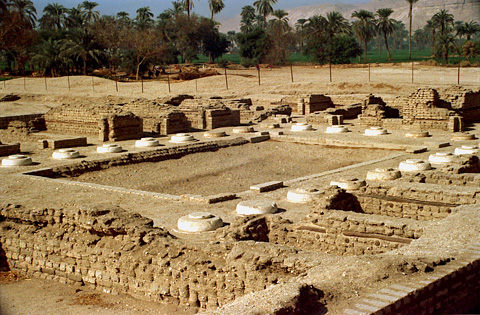 |
| ruins at Amarna (Akhetaten), courtesy, EgyptSites.wordpress.com |
Amarna
is located on the
eastern bank of the Nile in the modern-day province of Minya in central
Egypt, some 194 miles south of Cairo, and 36 miles south of the provincial
capital city of al-Minya. It is an extensive Egyptian archaeological site dating back to the Eighteenth Dynasty of ancient
Egypt. Today, several, largely indigenous Coptic villages are located adjacent
to, or around, the site: Deir Mawas,
el-Tell, el-Hagg Qandil, Deir el-Bersha, Mallawi.
“Amarna”
is actually Arabic, named after the Arab tribe that invaded and occupied the
place. It was originally called “Akhetaten” by the ancient Egyptians meaning “horizon
of the Aten” because it was built as the new capital city of the Pharaoh
Akhenaten, dedicated to his new religion of
worship to the Aten. Construction of Akhetaten started in or around Year 5 of his
reign (1346 BC) and was probably completed five years later, during which time,
it officially became the capital city. Most of the buildings were constructed
out of mud-brick,
and white washed. The most important buildings were faced with local stone.
It
was laid out roughly north to south along a "Royal Road" – the further from the Road, the poorer the
neighborhoods. The Royal residences were generally to the north, in what is
known as the North City, with a central administration and religious area. The South City was made up of residential
suburbs containing the estates of many of the city's powerful nobles, including Nakhtpaaten (Chief
Minister), Ranefer, Panehesy (High
Priest of the Aten) and Ramose (Master of Horses). This area also held the studio of the sculptor Thutmose, where the famous bust of Nefertiti, chief wife of Akhenaten,
was found in 1912.
South
of this area was Kom el-Nana, an enclosure, usually
referred to as a sun-shade, and was probably built as a sun-temple.
It was Akhenaten’s wish to have several temples of the Aten to be erected here,
as well as for the royal tombs to be
created in the area’s eastern hills for
himself, Nefertiti and
his eldest daughter Meritaten. The Maru-Aten, which was a palace or
sun-temple was originally thought to have been constructed for one of Akhenaten's wives Kiya, but on her death her
name and images were altered to those of Meritaten.
The
city greatly declined during the reign of his son Tutankhamun, who began to
reign two years after his father’s death. He decided to leave the city and
return to his birthplace in Thebes, but Akhetaten seems to have remained active
and a shrine to Horemheb indicates that it was at
least partially occupied at the beginning of the reign of that Pharaoh, if only
as a source for building material elsewhere.
After
the death of Horemheb, the city was finally abandoned and remained so until Egypt
came under Roman rule. Akhetaten revived and new settlements were established nearby along the edge of the Nile,
namely, the villages of Deir el Bersha and Mallawi, both established directly
across the river. When Christianity was introduced to Egypt, the
local inhabitants adopted the new religion and their descendants have remained
on that same spot since then.
During
the early period of Christianity, several local churches and monasteries were
established. In the 4th century, Saint Pishoy established his monastery, eventually named after him,
in Deir is Bersha. This was part of a chain of monasteries he established
throughout Egypt but when he died in 417, he was buried at the monastery in
Bersha alongside his friend and fellow “desert father” Saint Paul of Tammah who
died 2 years previously. However, some say it was his wish to be buried at one
of the other monasteries he founded, specifically one located at Wadi el Natrun,
in the north near the Nile Delta. In 841, his wish was carried out by Pope
Joseph I who transferred his remains accordingly. Other churches that were
prominent in Bersha include the Deir Abu
Fam Tombs Coptic Orthodox Church, the Church
in the Tomb of Urarna, and the Virgin
Mary and Anba Abraam Coptic Orthodox Church (destroyed by Arabs in 2013).
For
centuries thereafter, European explorers and archaeologists have occasionally covered
the area but in 1887, a local woman digging for sebakh, decomposed mud brick, uncovered a cache of over 300 cuneiform tablets (now commonly known as the Amarna Letters). These tablets recorded select diplomatic correspondence of the Pharaoh and were predominantly
written in Akkadian,
the lingua franca commonly used during the Late Bronze Age of the Ancient Near East for such communication. This discovery led to the
recognition of the importance of the site, and lead to a further increase in
exploration. In 1891, a “dig house”
was built by German archaeologist Ludwig Burchhardt as a storage base for
artefacts recently discovered.
Since
then, archaeologists have been making remarkable finds. They include: stelae dedicated to Isis and Shed, a cemetery of private
individuals, the Royal Wadi, the North Riverside
Palace, the Great Temple of
the Aten, the Small Aten Temple, the ceremonial residence of the King and Royal
Family, the Bureau
of Correspondence of Pharaoh,
the Boundary
Stelae (each a
rectangle of carved rock on the cliffs on both sides of the Nile) describing
the founding of the city, the Royal necropolis,
Workmen's village,
Tomb of Akhenaten,
Northern tombs,
Southern tombs,
Stelae U,
Desert altars,
Northern Palace, and Stelae H.


